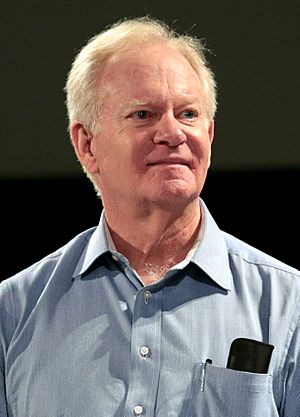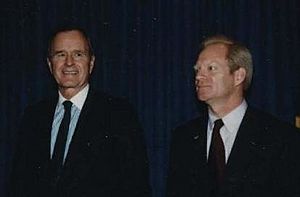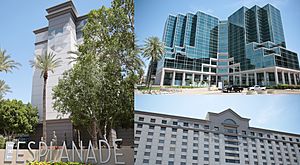Fife Symington facts for kids
Quick facts for kids
Fife Symington
|
|
|---|---|

Symington in 2017
|
|
| 19th Governor of Arizona | |
| In office March 6, 1991 – September 5, 1997 |
|
| Preceded by | Rose Mofford |
| Succeeded by | Jane Dee Hull |
| Personal details | |
| Born |
John Fife Symington III
August 12, 1945 New York City, U.S. |
| Political party | Republican |
| Spouse |
Ann Olin Pritzlaff
(m. 1976) |
| Relations | Stuart Symington (first cousin, once removed) Symington family |
| Parent |
|
| Education | Harvard University (AB) |
| Signature | |
| Military service | |
| Allegiance | United States |
| Branch/service | United States Air Force |
| Years of service | 1967–1971 |
| Rank | Captain |
| Battles/wars | Vietnam War |
| Awards | Bronze Star |
John Fife Symington III (born August 12, 1945) is an American businessman and politician. He served as the 19th Governor of Arizona from 1991 to 1997. Symington is a member of the Republican Party. He resigned from office in 1997 due to legal challenges, which were later resolved. Before becoming governor, Symington served in the United States Air Force. He was stationed at Luke Air Force Base in Glendale, Arizona.
Symington was born in New York City. He attended Harvard University and studied art history. His family was involved in politics; his father was an ambassador, and his cousin was a U.S. Senator. During his time in the Air Force, Symington earned the Bronze Star Medal for his service. After leaving the military, he became a real estate developer in Arizona.
As governor, Symington helped create charter schools in Arizona. He also signed laws to establish the Arizona Water Bank Authority. This agency helps save water for future needs. His time in office also saw the first temporary closure of Grand Canyon National Park during a federal government shutdown. After his time as governor, Symington became a chef and helped start the Arizona Culinary Institute. He is also known for being a witness to the famous Phoenix Lights, a mass UFO sighting in 1997.
Contents
Early Life and Career
Symington was born in New York City, New York, on August 12, 1945. He comes from a well-known family in Maryland. His great-grandfather was Henry Clay Frick, a steel businessman. Symington's father, J. Fife Symington Jr., was the United States Ambassador to Trinidad and Tobago. His cousin, Stuart Symington, was a U.S. Senator for Missouri.
Symington went to Gilman School in Baltimore. He then studied at Harvard University, graduating in 1968 with a degree in Dutch art history. While at Gilman, he met Thomas Caplan, who later introduced him to Bill Clinton. When Symington was 19, he rescued a young Bill Clinton from a strong ocean current during a trip to Hyannis Port, Massachusetts.
While at Harvard, Symington learned about the ideas of Friedrich Hayek. Hayek was an economist who believed in limited government and free markets. These ideas influenced Symington's political views on money and taxes. Symington also supported Barry Goldwater in the 1964 presidential election.
In 1967, Symington joined the United States Air Force during the Vietnam War. He was stationed at Luke Air Force Base near Glendale, Arizona. In 1971, he received the Bronze Star Medal for his excellent service. He was then honorably discharged from the military.
After his military service, Symington stayed in Arizona. He became involved in real estate development. In 1976, he started his own company, The Symington Company. In 1983, he joined the board of directors for Southwest Savings and Loan Association.
Real Estate Projects
One of Symington's major real estate projects was building The Esplanade. This was an upscale office complex in Phoenix. Construction began in 1983 and finished in 2003. Symington believed it was a prime location for businesses. The financing for this project later became part of an investigation.
Another project by The Symington Company was the Mercado. This was a shopping complex near downtown Phoenix. Its design was inspired by southwestern and Hispanic culture. The Mercado opened in 1989. However, it faced financial challenges a few years later. Symington's company also developed the Scottsdale Seville.
Governor of Arizona
1990 Election Campaign
In April 1989, Symington announced he would run for Governor of Arizona. He promised to manage the state like a business. He highlighted his business skills and success as a real estate developer. In the Republican primary election on September 11, 1990, Symington faced several experienced politicians. These included former governor Evan Mecham. Symington won the primary with nearly 44% of the votes.
In the general election, Symington's opponent was Terry Goddard. Goddard was the Democratic nominee and had been the mayor of Phoenix. Goddard's father, Samuel Pearson Goddard Jr., was also a former Arizona Governor. During the campaign, Goddard raised questions about Symington's business activities. Symington, in turn, accused Goddard of breaking campaign finance laws.
On election day in November 1990, Symington and Goddard were very close in votes. Symington was ahead by only 4,300 votes. Arizona had recently adopted a runoff voting rule. This meant if no candidate got more than 50% of the vote, a second election would be held. This rule was put in place after Governor Evan Mecham was elected with only 40% of the vote in 1986. So, a runoff election was scheduled for February 26, 1991.
Before the runoff, Symington was called to speak before the United States Senate Committee on the Judiciary. This was seen by some as a political move. Symington went on to win the runoff election with 52% of the vote. After this long campaign, Arizona changed its rules back to plurality voting. This made the 1990 election the only statewide runoff election in Arizona's history.
First Term (1991–1995)

Symington became governor on March 6, 1991. He was Arizona's fourth governor in five years. His first state budget, over $3.5 billion, passed without tax increases. This earned him praise from political experts. He also stopped a controversial waste incineration project.
Symington started a project called Project SLIM (State Long-Term improved Management Project). Its goal was to make the state government smaller and reduce spending. This project looked for ways to improve hiring, training, and employee processes. It also aimed to reduce the number of state employees.
In November 1992, Symington reached an agreement with the Fort McDowell Yavapai Nation. This allowed the tribe to operate video gambling machines. This agreement ended a long disagreement with federal agents. Symington later signed a law in 1993 that outlawed most gambling and casinos. Also in November 1992, Symington supported bringing back Martin Luther King Jr. Day as a federal holiday in Arizona. The holiday had been removed earlier. Symington was proud that Arizona voted to approve the holiday.
One of Symington's big achievements was education reform. This led to the creation of charter schools in Arizona. The first charter schools opened in 1995. The goal was to improve student learning and offer more school choices. Symington believed that charter schools would encourage public schools to improve through competition.
1994 Election Campaign
Symington ran for a second term as governor in 1994. In the Republican primary, he faced Barbara Barrett. Symington stated that he had achieved his goals of controlling state spending, reducing taxes, and improving the economy. On September 13, 1994, Symington defeated Barrett with 68% of the vote.
In the general election, Symington ran against Democratic candidate Eddie Basha. Basha was well-known as the CEO of Bashas' grocery stores. Opinion polls initially showed Basha leading Symington. However, the 1994 midterm elections were a big win for Republicans across the country. This likely helped Symington.
Symington won the election with 52% of the vote. Basha received 44%. Symington highlighted Basha's comment that public schools could be a "surrogate family." Symington argued that this meant Basha believed the state could replace families. After his victory, Symington promised to further reduce state income taxes. He also pledged to reduce rules for businesses and "get tough on crime." He called his win a "miracle" and a "revolution."
Second Term, Legal Challenges, and Resignation (1995–1997)
Early in his second term, Symington faced personal financial difficulties. He filed for bankruptcy, stating he had over $24 million in debt. This was due to problems with his real estate investments. He had borrowed $10 million from union pension funds for his Mercado shopping center project. When the Mercado did not earn enough money, Symington could not make payments. This led to a court order for him to pay $11.4 million, which he said he could not afford.

In November 1995, Grand Canyon National Park closed for the first time. This happened because of a federal government shutdown. Symington believed the closure hurt tourism. He stated the Grand Canyon "must remain open, by force, if necessary." The Pentagon warned against using force. Symington went to the canyon with National Guard troops and state park employees. He demanded the park be reopened.
The park superintendent told Symington that Arizona could donate money to reopen the Grand Canyon. Symington called this a "political game." The Department of Interior later reopened the park under state supervision. The federal government later paid Arizona back for the money it donated. The government shut down again in December, but an agreement was made to keep the park partly open. Arizona paid daily fees, which were also later reimbursed.
In 1996, Symington signed a law creating the Arizona Water Bank Authority. This agency collects extra water from the Central Arizona Project and stores it for future use. This law helped Arizona deal with droughts better than other states.
Later in 1996, Symington faced legal charges. He was accused of bank fraud and other financial wrongdoings related to his real estate business. On September 4, 1997, he was found responsible for some of these charges. Because Arizona law does not allow people with such findings to hold office, Symington resigned the next day. Jane Dee Hull, who was then Secretary of State, became the new governor.
However, in 1999, a higher court overturned these findings. The court ruled that Symington's right to a fair trial had been affected. Before the government could try him again, President Bill Clinton pardoned Symington in January 2001. This ended the legal battle.
After Being Governor
Arizona Culinary Institute
While his legal case was being reviewed, Symington decided to try a new career. He enrolled in culinary school. He said it was "very educational and very humbling." After graduating from the Le Cordon Bleu College of Culinary Arts Scottsdale, Symington helped start the Arizona Culinary Institute. He co-founded the school with chef Robert E. Wilson, businessman Jerry Moyes, and Darren Leite. The school opened in Scottsdale in early 2002. It focuses on small classes and hands-on training, especially in traditional French cooking.
Symington also returned to The Esplanade, a real estate project he had started. He worked there as a dessert and pastry chef at an Italian restaurant called Franco's Italian Caffe. He opened the restaurant in February 2003 with a business partner, Franco Fazzuoli. Symington had previously worked as an intern at one of Fazzuoli's restaurants while in culinary school.
Symington once said he would rather be a chef than "making money." His specialties included tiramisu and a chocolate mousse recipe he created called "The Governor (high taste, low taxes)." This dessert was very popular at the restaurant.
Phoenix Lights
In 2007, Symington shared that he had witnessed the Phoenix Lights. This was a large UFO sighting that happened on March 13, 1997, when he was governor. He said, "I'm a pilot and I know just about every machine that flies. It was bigger than anything that I've ever seen. It remains a great mystery." He described it as "enormous and inexplicable" and "too symmetrical" to be flares.
As governor at the time, Symington had joked about the event. He held a press conference where his chief of staff dressed in an alien costume. He later explained that he felt a duty to prevent public panic and wanted to add some humor to the situation.
On November 9, 2007, Symington appeared on Larry King Live to discuss UFO experiences. A few days later, he led a UFO press conference in Washington, D.C. He and other witnesses urged the U.S. government to look into UFO sightings more seriously. Symington also appeared in an updated version of the 2002 UFO documentary Out of the Blue.
In 2017, Symington wrote an article for CNN. He described seeing a large, silent, delta-shaped craft with "enormous lights" over Piestewa Peak. He disagreed with the Air Force's explanation that it was just flares. He called for more investigations and for the government to stop dismissing all UFO sightings.
Possible Return to Politics
In 2005, Symington expressed interest in running for governor again in 2006. However, he later decided not to run, choosing to focus on his business, The Symington Group. In 2006, he lost a bid to become the Republican Party Chairman for his local district. In 2007, he became chairman of the board of trustees for the Santa Barbara Botanic Garden.
After Governor Janet Napolitano resigned in 2009, Symington was again considered for the 2010 gubernatorial election. But he decided not to run. He has continued to be involved in state politics by supporting various candidates from both major parties. These include Doug Ducey for governor and John McCain for U.S. Senate.
In 2017, Symington became treasurer for Jay Heiler's U.S. Senate committee. Heiler had been Symington's Chief of Staff as governor. Heiler later decided not to run for the Senate. In 2018, there were reports that Symington was thinking about running for the U.S. Senate in the 2020 special election. He said he would enjoy campaigning against potential Democratic candidate Grant Woods. Symington believed his past legal issues would not affect his candidacy. In September 2021, Symington became co-chair for Karrin Taylor Robson's campaign for governor.
Later Life and Legacy
In 2012, Symington wrote an article reflecting on his time as Governor of Arizona. He spoke positively about his experiences, despite the legal challenges he faced. He wrote that Arizona's government worked well during his term. He also praised Arizona for being the home of charter schools, an idea that started when he was governor.
In 2016, an Arizona historian found a large collection of missing documents from Symington's time as governor. There were 305 boxes of policy papers, trial records, photos, and even a humorous photo of Symington in a Phoenix Suns gorilla costume. These records were found in a storage facility. State law requires public officials to make their records available to the public.
On February 9, 2017, an exhibit called "The Surreal Life of Fife Symington" opened at the Arizona Capitol Museum. It featured personal items and family history items found by Symington. The exhibit included political campaign materials, Symington's Bronze Star, and yearbooks.
Personal Life
Fife Symington has two children and five grandchildren from his first marriage. His second wife was Ann Olin Pritzlaff, who is an ordained deacon in the Episcopal Church. They have three children and eight grandchildren. He is currently married for the third time.
Electoral history
| Republican primary for the 1990 Arizona gubernatorial election | |||||
|---|---|---|---|---|---|
| Party | Candidate | Votes | % | ±% | |
| Republican | Fife Symington | 163,010 | 43.78% | ||
| Republican | Evan Mecham | 91,136 | 24.48% | ||
| Republican | Fred Koory | 61,487 | 16.51% | ||
| Republican | Sam Steiger | 49,019 | 13.17% | ||
| Republican | Bob Barnes | 7,672 | 2.06% | ||
| Arizona gubernatorial general election, 1990 | |||||
|---|---|---|---|---|---|
| Party | Candidate | Votes | % | ±% | |
| Republican | Fife Symington | 523,984 | 49.65% | ||
| Democratic | Terry Goddard | 519,691 | 49.24% | ||
| Write-ins | 11,731 | 1.11% | |||
| Arizona gubernatorial runoff election, 1991 | |||||
|---|---|---|---|---|---|
| Party | Candidate | Votes | % | ±% | |
| Republican | Fife Symington | 492,569 | 52.36% | ||
| Democratic | Terry Goddard | 448,168 | 47.64% | ||
| Republican primary for the 1994 Arizona gubernatorial election | |||||
|---|---|---|---|---|---|
| Party | Candidate | Votes | % | ±% | |
| Republican | Fife Symington | 202,588 | 68.14% | ||
| Republican | Barbara Barrett | 94,740 | 31.86% | ||
| Arizona gubernatorial election, 1994 | |||||
|---|---|---|---|---|---|
| Party | Candidate | Votes | % | ±% | |
| Republican | Fife Symington | 593,492 | 52.54% | ||
| Democratic | Eddie Basha | 500,702 | 44.33% | ||
| Libertarian | John Buttrick | 35,222 | 3.12% | ||
| Write-ins | 191 | 0.02% | |||
See also
 In Spanish: Fife Symington para niños
In Spanish: Fife Symington para niños
- List of governors of Arizona
- List of people pardoned or granted clemency by the president of the United States




